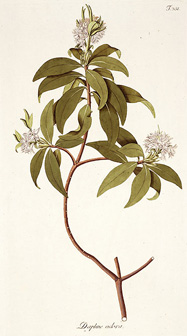Difficult Daphne
By Audrey Stallsmith

Why do you follow me?
Any moment I can be
Nothing but a laurel tree.
"Daphne" by Edna St. Vincent Millay
Daphne has a reputation for temperament and the most desirable species, Daphne odora, is reportedly the most unpredictable of the lot. As the New Sunset Western Garden Book (edited by Kathleen Norris Brenzel) warns, “It can die despite the most attentive care, or flourish with little attention until you invite all your gardening friends over to admire it, at which point it promptly succumbs without warning just to show you who’s in charge.”
It's not showy either, with small pinkish-white four-petal flowers on bay-like bushes. In Greek myth, the nymph Daphne metamorphosed into the plant to escape the pursuit of Apollo. The odora part of the name indicates why so many gardeners now lust after the shrub--for its intoxicating fragrance that combines elements of both rose and spices.
Strangely enough, the man who “discovered” it in China in 1770 wasn’t even a botanist, but an employee of the East India Company. Benjamin Torin apparently had a knowledgeable nose, however, as he only ever sent one shipment of plants home to England—but it included such scent superstars as Daphne odora, Osmanthus fragrans, and Murraya exotica. As Tovah Martin puts it in The Essence of Paradise, “Somehow he hit the jackpot in that sole attempt.”
As its common name, winter daphne, indicates, Daphne odora can bloom during the coldest season in the states where it is hardy -- USDA zones 7 to 9. That, however, is not a sure thing either.
John Sims notes in an 1813 issue of Curtis’s Botanical Magazine that “unless the season prove favorable, it frequently fails of flowering altogether, otherwise it would be a most desirable acquisition; producing its highly fragrant flowers in a season when it has few rivals.” At the cooler end of its range, the shrub will wait until early spring to perform.
In the north you may be able to force a plant into winter bloom by keeping it in a cool greenhouse or an unheated sun porch, where temperatures remain chilly but above 45 degrees Fahrenheit. First, however, it must endure night-time temperatures below 40 degrees for several weeks to cue it to set buds. Martin emphasizes that a potted specimen should be kept in very light soil in a clay pot, and must never be overwatered.
Victorian gardeners excelled at this forcing, since their homes and conservatories were much colder than ours. Those of us in northern climes will probably find it easier to plant hardy Daphne x burkwoodii types, which bloom in late spring, instead—or possibly Daphne mezereon varieties which flower before their leaves open. They should be placed in sandy, slightly acidic ground and mulched well to keep their roots cool.
The bark of mezereon was once used to induce blisters on the skin, while its berries were eaten as a laxative. Those berries are toxic in large doses, however, so I would stick to over-the-counter remedies!
Daphne odora’s difficult disposition may be responsible for one of its meanings in the Language of Flowers: “I would not have you otherwise.” After all, as with human personalities, some of the most difficult are also the most interesting! The flower also stands for “painting the lily,” probably due to its pinkish tinge, or "sweets to the sweet" in reference to its fragrance. The "desire to please" sometimes included in that list was probably just deluded wishful thinking!
At least, when this plant leaves you, it does so as decisively as the nymph spurned Apollo. “Daphne," Martin comments, "doesn’t believe in long, drawn-out goodbyes.”
Daphne odora image is from Plantarum Rariorum, courtesy of the Missouri Botanical Garden.








